DIY Guide for Leaks and High Bills
If your water bill is higher than usual, you might have a leak. Some leaks may look like a steady drip but over the course of weeks can amount to hundreds of gallons of water. The good news: You can do many of the repairs yourself.
All EBMUD customers have a meter that measures their water use. Water bills reflect how much water was used since the last meter reading. Meters measure cubic feet of water used (one cubic foot equals 7-1/2 gallons). EBMUD bills in units of 100 cubic feet (748 gallons). Meters are usually in the ground under a cement cover with an EBMUD logo by the street near the curb.
There are two types of meters: a straight-reading meter which looks like an odometer, and the older round-reading meter with separate dials.
How to read a straight-reading meter:
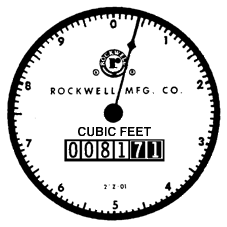
If you used 1,200 cubic feet of water during the next billing period, the next meter reading would be 008171 plus 1200, equaling 009371 cubic feet, or 93 units. Your bill would be based on the difference between the two readings, or 12 units at 748 gallons per unit (8,976 gallons).
Note: the large hand is used only for testing purposes and leak detection. Newer meters also have a small triangle that is usually red or blue, that spin when water is used.
How to read a round-reading meter:
There are two styles of round-reading meters, that read much like a clock. Both contain dials marked off in divisions of “10,” “100,” “1,000,” “10,000,” “100,000”. The ”one foot” dial is used for testing, not reading. The same is true for the unmarked dial, which is used only for testing.
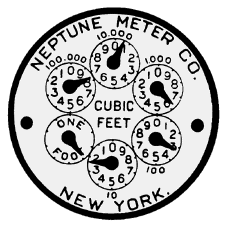
Start with the “100,000” dial, then read each dial in a clockise direction to the “10” dial. Record each number. If the hand is between numbers use the lower number. In this example, the left meter registers 8,0,6,3 and 2, respectively (80,632 cubic feet). Disregard the last two numbers (32), because our charge is based on units of 100 cubic feet. The number of units registered is 806.
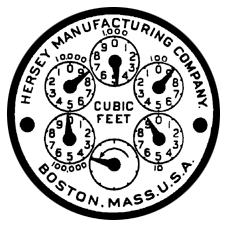
The meter on the right registers as 9,8,4,8, and 9, equaling 98,489 cubic feet or 984 units. If you were to use 13 more units by the next time your meter was checked, the reading would be 997 units. Disregard the last two numbers (89), because our charge is based on units of 100 cubic feet.
There are variations in EBMUD meters, so be sure you check which way each dial is turning when you make a reading. If you have questions about your meter or water service, call 1-866-40-EBMUD.
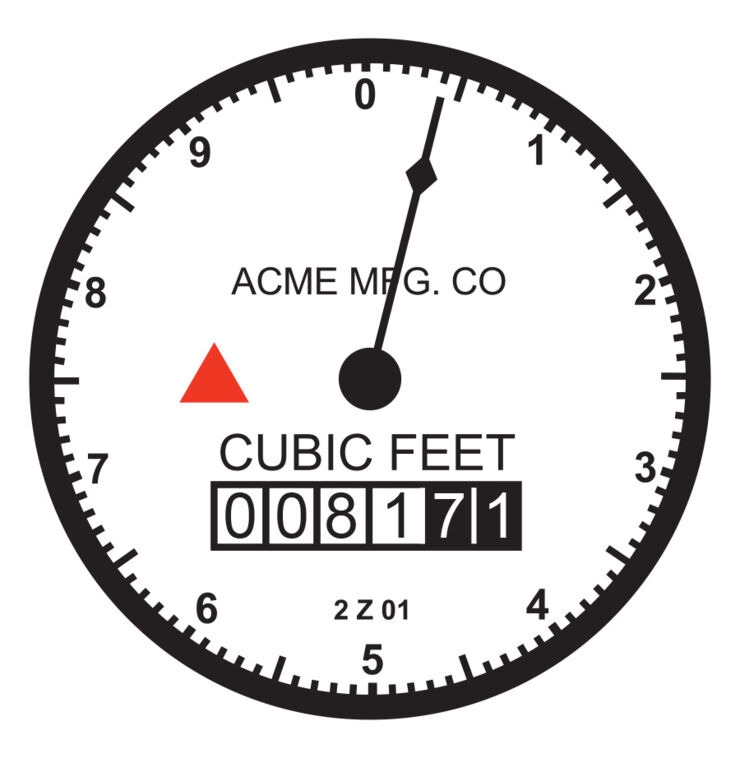
Find your water meter. It’s usually in the ground under a cement cover with an EBMUD logo by the street near the curb. Lift the cement cover to the side, then flip open the hinged lid of the meter inside. You’ll find either a straight-reading or round-reading dial.
On straight-reading meters, use the large needle to test. On round-reading dials, the test dial will be labeled “one-foot” or won’t have any markings.
- Make sure all indoor and outside faucets are shut off and no one is using water. Mark the needle(s) by laying a straight pin or toothpick exactly on top.
- Do not use any water for 30 minutes.

If the test needles moved, you probably have a leak. Certain leaks may occur intermittently, like a running toilet, and don’t register continuously at the meter.
Check all plumbing fixtures to identify fixtures in need of repair including faucets, toilets, water heaters, and irrigation systems.
Determine if the leak is inside or outside by locating the main shut-off valve (usually at the front of the house under an outside faucet). If the dial moves while the main house valve is off, you likely have an underground leak.
Look for overly green or wet spots between the meter and house valve, and look for surface water or wet spot(s) elsewhere that may indicate an irrigation system leak.
Toilet leaks are the number one cause of high water bills. The leak may be caused by a failing flapper, plunger ball, float ball or fill valve.
- First, listen for hissing or trickling sounds, or a periodic “whoosh” caused by the toilet topping itself off every few minutes. These are all signs that a leak exists.
- Drop a dye tablet or several drops of ordinary food coloring into the toilet tank. (EBMUD has free dye tabs for you.) Wait a few minutes. If color shows up in the toilet bowl, you have a leak.
- Next, turn off the toilet’s water supply (usually it has a diamond shaped handle, near the wall at the base of the toilet) and mark the water level inside the tank. Wait 15 minutes and then check the water level.
- If it has dropped below your mark, the problem is at the bottom of the toilet tank at the flapper or plunger ball. However – if the water level has stayed the same, then the problem is an overflow near the top of the tank, involving the float ball or the fill valve – or both.

Tip: look for products labeled chloramine resistant at your hardware store.
A few minutes is all you need to check for leaks.

Most people visit their water heaters only if the hot water stops. Check yours. If you notice a puddle of water around the bottom of the tank, it probably indicates a leak caused by corrosion – a sign of old age. If the tank wall is corroding, more problems are coming, and it’s time to retire the tank and get a new energy-saving model.
Water heaters last about 15 years with proper care. To clear out any sediment, flush a few quarts of water from the drain valve at the bottom of the tank into a bucket about every six months. Also operate the pressure-relief valve at the top of the tank. Don’t worry if a little water leaks out; that means it’s working. Also close and reopen the cold-water inlet valve at the top, so you’re sure it’s easy to operate in an emergency.
If your pool has an automatic fill valve, make sure it is fully turned off. Then place a bucket on a pool step. Fill the bucket with pool water to about three to four inches from the top, matching the water level in the bucket with the level of the pool. Carefully mark the water levels on both the inside and outside of the bucket. Wait 24 hours. If the pool water has dropped faster than the bucket’s contents, you may have a leak. Contact a pool professional for help.
Whatever irrigation equipment you have – manual, sprinkler or drip – be aware that not all leaks are obvious. First check for overly green or soggy spots, where broken spray heads or bubblers or underground pipe cracks will tell on themselves. Buried pipes, hoses or drip lines leaking into sandy, porous soil may not show up clearly. Automatic sprinkler and drip systems that generate a hissing sound are likely leaking.
Remember to check drip systems for damage from foot traffic or gnawing pets or pests. Got leaky hoses? Repair them with waterproof tape. Dribbling spray nozzle connection? Wrap the hose threads with Teflon tape.
Request that a free do-it-yourself Home Survey Kit be sent to your service address. The Home Survey Kit can help you find and fix leaks and check water flow rates. When you return the survey form included in the kit, EBMUD will provide free water-saving devices, if needed.
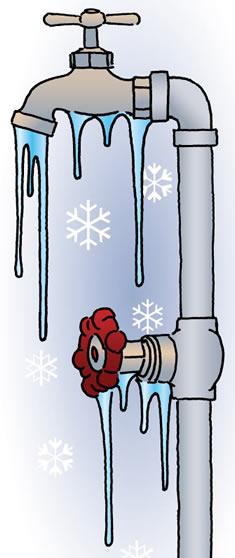
Freezing nighttime temperatures can damage exposed water lines and automatic irrigation valves that control the water to your sprinklers and drip emitters.
Plumbing exposed to the open air is most vulnerable to freeze damage—usually irrigation valves or where the water service line enters a building. If water freezes inside exposed water lines and valves, the force of expansion can be enough to crack pipes or break joints.
If your pipes have frozen
DO wrap the house valve in a towel and slowly pour warm (not boiling) water over it. You'll find warm water in the bottom of your water heater.
DON'T use a torch, heater or any open flame.
Prevent pipe freezing
DON’T try to prevent freezing by opening a faucet to keep the water moving in the pipes. This is an unnecessary waste of water.
DO wrap exposed plumbing parts with insulating material from your hardware or home improvement store. Old towels will work in a pinch. It's also a good idea to insulate faucets and pipes in unheated areas (garages, crawl spaces).
DO protect automatic irrigation valves from freeze damage by shutting off the valve in the water line that feeds those valves. Then, use your irrigation timer to turn on each valve for a minute to drain water from the valves and pipes.
DO turn your irrigation system off for the winter and let winter rains and cooler weather care for your plants.
DO open the shut-off valve(s) and test your irrigation system before starting it back up in the spring.
If you are experiencing a water emergency, call 1-866-403-2683. Water emergencies may include open hydrants, main breaks, or other EBMUD water-related emergencies.
Text message or email notifications help you stay alerted to important or unexpected increases in your water bill.
To set up notifications, go to your 'My Water Report' portal, click on 'Settings' to adjust Communication Preferences.
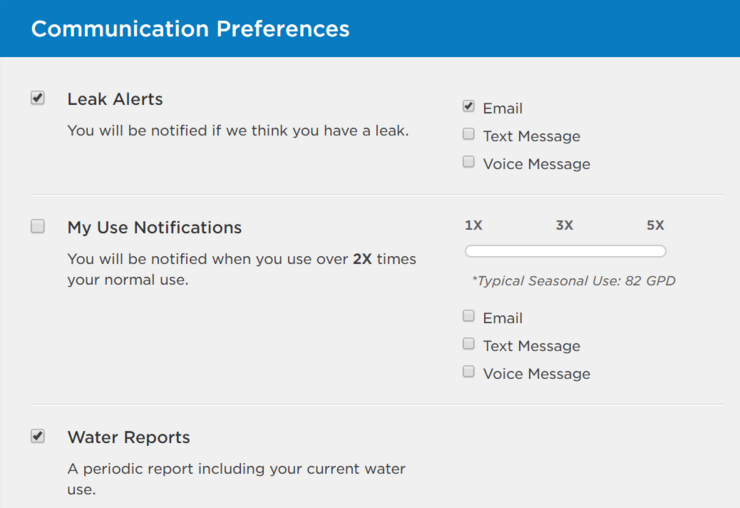
Other causes of high bills
High water bills may also be caused by frequent watering of a new or existing lawn or landscaping; a faulty irrigation timer; filling a swimming pool; an increase in the number of occupants or employees in a household or business; water theft; and open faucets or irrigation systems.
For more information
For more information about leaks in your home or leaks in the street, see Water leaks frequently asked questions.